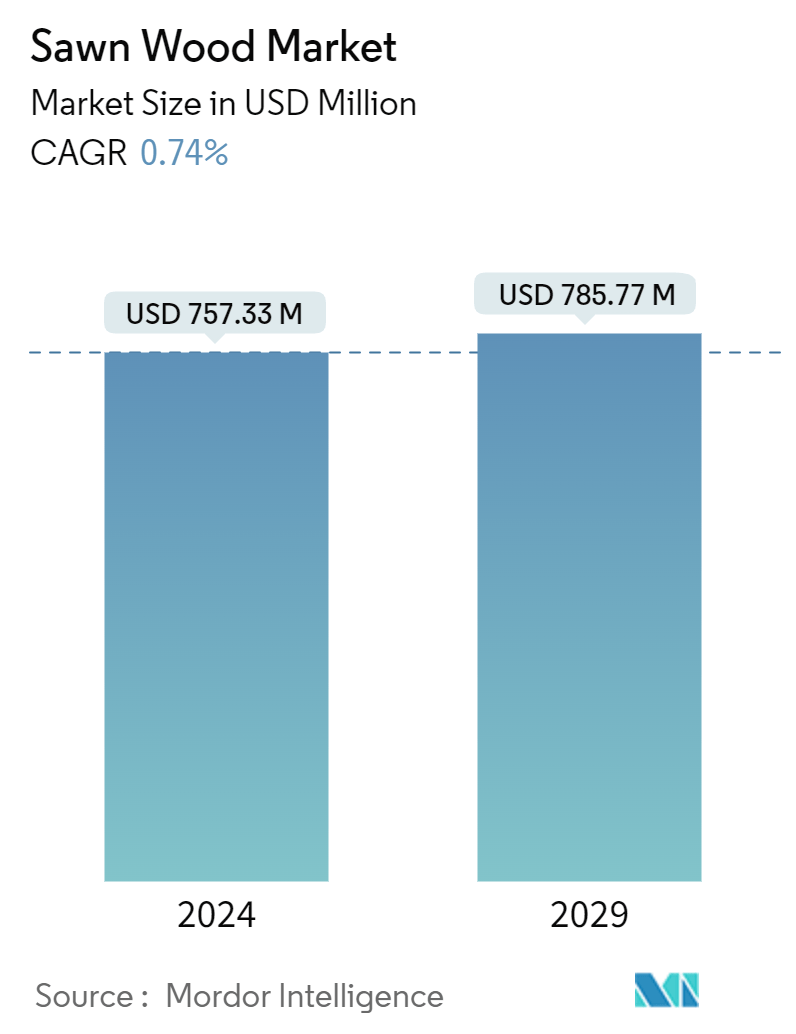Market Size of Sawn Wood Industry

| Study Period | 2019 - 2029 |
| Market Size (2024) | USD 757.33 Million |
| Market Size (2029) | USD 785.77 Million |
| CAGR (2024 - 2029) | 0.74 % |
| Fastest Growing Market | North America |
| Largest Market | Asia-Pacific |
Sawn Wood Market Analysis
The Sawn Wood Market size is estimated at USD 757.33 million in 2024, and is expected to reach USD 785.77 million by 2029, at a CAGR of 0.74% during the forecast period (2024-2029).
- The global sawn wood market plays a pivotal role in the timber and forestry industry, serving sectors such as construction, furniture manufacturing, and packaging. Fueled by a growing appetite for sustainable materials, and an increase in the percentage of the urban population that has surged in construction activities, the studied market has witnessed notable expansion. For instance, as per the World Bank, the global urban population in 2021 was 56% which increased and reached 57% in 2023. Demand for sawn wood is predominantly spurred by the construction and real estate sectors, utilizing it for framing, flooring, and various structural applications. Notably, the residential housing segment stands out as a primary demand driver. Additionally, the packaging sector's appetite for sawn wood, especially for pallets and crates, is on the rise. This surge is largely attributed to the e-commerce boom and global trade dynamics, further propelling the market's growth.
- Furthermore, the escalating preference for sustainable and eco-friendly building materials is amplifying market growth. As the emphasis on sustainable building practices intensifies, wood is increasingly favored as an eco-friendly alternative to steel and concrete. There's a growing prominence of certified wood products, notably those endorsed by the Forest Stewardship Council (FSC) and the Programme for the Endorsement of Forest Certification (PEFC). Yet, challenges loom in the form of global environmental concerns, particularly deforestation, which could hinder sustainable growth. Regions with stringent environmental regulations are likely to see a pronounced benefit from the industry's shift towards green building practices and sustainable materials.
Sawn Wood Industry Segmentation
Sawn wood refers to wood that has been cut from logs into various shapes and sizes. For the purpose of the study, both coniferous and non-coniferous sawn wood is considered. The sawn wood market is segmented by type (Hard wood and Soft wood) and geography (North America, Europe, Asia-Pacific, South America, and Middle East & Africa). The report includes the production analysis (volume), consumption analysis (value and volume), export analysis (value and volume), import analysis (value and volume), and price trend analysis. The report offers the market size and forecasts in terms of volume in metric tons and value in USD for all the above segments.
| Type | |
| Hard Wood | |
| Soft Wood |
| Geography (Production Analysis in Volume, Consumption Analysis by Volume and Value, Import Analysis by Value and Volume, Export Analysis by Value and Volume, and Price Trend Analysis) | ||||||||
| ||||||||
| ||||||||
| ||||||||
| ||||||||
|
Sawn Wood Market Size Summary
The sawn wood market is experiencing a steady growth trajectory, driven by its diverse applications in construction, furniture, and paper production. As a renewable and environmentally friendly material, sawn wood is increasingly replacing non-renewable resources, aligning with global sustainability efforts. The market's expansion is significantly influenced by rising income levels, which boost demand for wood products, particularly in the housing sector. The Asia-Pacific region, with China as a major consumer, leads the global market due to its burgeoning furniture industry and construction activities. Other key players in the region include Japan, Turkey, Vietnam, India, Thailand, and Malaysia, contributing to the region's dominant position in sawn wood production and consumption.
Globally, the production of sawn wood is on the rise, fueled by urbanization, population growth, and the evolving demand from the furniture and construction sectors. The market is characterized by increasing trade volumes, with major producing countries witnessing enhanced export and import activities. The Asia-Pacific region, accounting for a significant portion of global production, continues to see increased imports driven by high consumption demand. The region's market dynamics are supported by favorable climatic conditions and a robust construction sector. Despite challenges such as regulatory measures and market fluctuations, the sawn wood industry is poised for continued growth, with ongoing developments in production and trade expected to shape its future landscape.
Sawn Wood Market Size - Table of Contents
-
1. MARKET DYNAMICS
-
1.1 Market Overview
-
1.2 Market Drivers
-
1.2.1 Growing Construction Activity
-
1.2.2 Boom in the Furniture Industry
-
1.2.3 Technological Advancements in Wood Processing
-
-
1.3 Market Restraints
-
1.3.1 Environmental Concerns and Deforestation
-
1.3.2 Supply Chian Disruptions
-
-
1.4 Value Chain Analysis
-
-
2. MARKET SEGMENTATION
-
2.1 Type
-
2.1.1 Hard Wood
-
2.1.2 Soft Wood
-
-
2.2 Geography (Production Analysis in Volume, Consumption Analysis by Volume and Value, Import Analysis by Value and Volume, Export Analysis by Value and Volume, and Price Trend Analysis)
-
2.2.1 North America
-
2.2.1.1 United States
-
2.2.1.2 Canada
-
-
2.2.2 Europe
-
2.2.2.1 Russia
-
2.2.2.2 Germany
-
2.2.2.3 Sweden
-
2.2.2.4 Finland
-
2.2.2.5 Austria
-
-
2.2.3 Asia-Pacific
-
2.2.3.1 China
-
2.2.3.2 India
-
2.2.3.3 NewZeland
-
2.2.3.4 Australia
-
2.2.3.5 Vietnam
-
2.2.3.6 Japan
-
-
2.2.4 South America
-
2.2.4.1 Brazil
-
2.2.4.2 Argentina
-
-
2.2.5 Middle East And Africa
-
2.2.5.1 Turkey
-
2.2.5.2 Egypt
-
2.2.5.3 Nigeria
-
-
-
Sawn Wood Market Size FAQs
How big is the Sawn Wood Market?
The Sawn Wood Market size is expected to reach USD 757.33 million in 2024 and grow at a CAGR of 0.74% to reach USD 785.77 million by 2029.
What is the current Sawn Wood Market size?
In 2024, the Sawn Wood Market size is expected to reach USD 757.33 million.

